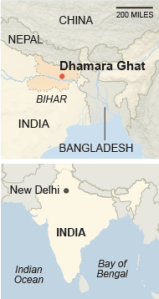I’ve argued elsewhere that pilgrimage is a barometer of religious pluralism and political openness, in part because pilgrimage requires populations to travel across borders and access shrines. In some cases, the shrines may be associated with a minority religious tradition, or even embattled, multiple claims to a sacred site. Moreover, once pilgrims have reached a shrine, they must be able to return home again.
Al-Jazeera has reported that 2014 opened with sectarian violence and a suicide car bombing near Quetta on Pakistani Shias returning from a pilgrimage to Iran. Of 50 pilgrims on a bus, at least two pilgrims were killed in the attack. These pilgrims had successfully made their journey, and they were coming home again — and they weren’t attacked until they were back inside Pakistani borders.
Borders can prove challenging for pilgrimage: I have written about Shia pilgrims, many Iranian, traveling across borders to shrines in Iraq. In these cases, not only are pilgrims themselves deeply symbolic in political and religious conflicts. Rather, pilgrimage places — and movement back and forth to these places — also make the conflict physical, focusing on a particular location and the historic meaning invoked by that place.
 In that sense, I find it useful to think about pilgrimage, movement, and conflict by looking at a map. Here’s a political map showing the internationally recognized borders of Pakistan, Iran, and surrounding countries. Just the extent of the political borders here gives some sense of the vulnerability of pilgrims crossing from one country to another — and, as the Al-Jazeera report states, the method of travel in a large passenger bus, creates a particular target.
In that sense, I find it useful to think about pilgrimage, movement, and conflict by looking at a map. Here’s a political map showing the internationally recognized borders of Pakistan, Iran, and surrounding countries. Just the extent of the political borders here gives some sense of the vulnerability of pilgrims crossing from one country to another — and, as the Al-Jazeera report states, the method of travel in a large passenger bus, creates a particular target.
 Here’s a map that specifically shows Quetta, Pakistan — the attack occurred on the outskirts of this city. There’s a context of place here, including a rise in sectarian violence between Sunni and Shia Muslims in Pakistan in 2013 near Islamabad. This impacts the climate for pilgrims as far away as Quetta — and two bomb attacks on Shias and the Hazara ethnic community killed almost 200 people last year.
Here’s a map that specifically shows Quetta, Pakistan — the attack occurred on the outskirts of this city. There’s a context of place here, including a rise in sectarian violence between Sunni and Shia Muslims in Pakistan in 2013 near Islamabad. This impacts the climate for pilgrims as far away as Quetta — and two bomb attacks on Shias and the Hazara ethnic community killed almost 200 people last year.








